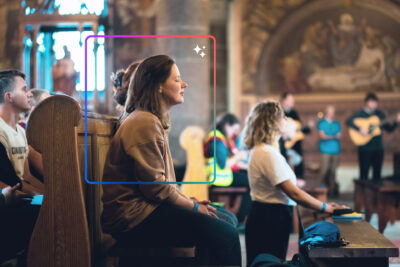
Happy Birthday to the iPhone, the Device That’s Changing the Church
As we celebrate the 10th anniversary of the launch of the iPhone, it’s a good time to reflect on the immense changes the device brought to the church.
Certain dates define eras. You know the list:
- October 29, 1929 (The stock market crashes)
- December 7, 1941 (The Japanese attack Pearl Harbor)
- February 9, 1964 (The Beatles play the Ed Sullivan show)
- September 11, 2001 (Terrorists attack the World Trade Center and the Pentagon)
June 29, 2007, will one day be on that list. Maybe we should have realized from the start just how important that day would become. Apple enthusiasts waited nearly six months after Apple CEO Steve Jobs first announced the iPhone in January—they slept in parking lots to get their hands on the first iPhones to hit the market. Lines were unfathomably long. The world took notice.
Certain Inventions Change Everything
But few people really realized how much the world would change on that day. Early reviewers questioned the virtual keyboard, debated whether consumers would like the touch screen, and stated in unequivocal terms that consumers weren’t ready for (or weren’t interested in) convergence devices that combined mobile calling with the internet.
Wrong, wrong, and wrong.
But most importantly, all of us (minus possibly Steve Jobs himself) missed just how much that one innovation would change how we live (for both good and bad). When Jobs first introduced the iPhone during his (now famous) January 2007 keynote presentation, he said, “Every once in awhile a revolutionary product comes along that changes everything.”
And he was right. We’re different because of June 29, 2007. We spend our time differently. We make purchases differently. We communicate differently.
We’re just different.
I won’t bore you with all the stats. We’ll just focus on a few:
- The average person now spends three hours a week engaging digital content on a mobile device.
- More than three-quarters of Americans own smartphones.
- The average person checks his or her smartphone 110 times a day.
Most of us understand all of that. We get the overwhelming cultural significance of smartphones (and maybe to a degree the importance of the iPhone in truly making smartphones accessible to all). What we often don’t stop and think about is how the smartphone is changing our churches—in some ways, radically. In fact, some of these changes we may not fully realize for decades to come.
How Mobile Is Changing the Church
Here are four of those important changes for which we have the iPhone (and other early smartphones) at least partially to thank.
1. Worship services aren’t limited by location or even a wifi signal
A decade ago, we had two options when it came to worship services: We either had to get people into our church buildings or hope they could watch us in a place with solid wifi. But those days are no more. Today, members can watch worship services from their beds, from the beach, or from a favorite coffee shop.
Of course, there’s a caveat to that. Our members not only have access to our sermons wherever they are, but they have access to everyone else’s sermons as well. A decade or two ago, most of your members only watched your services. Today, they visit your church on Sunday and listen to podcasts of nationally-known preachers throughout the week.
Here’s the crazy, almost counterintuitive transformation that smartphones have helped to usher in. Today, your worship service “experience” is even more important than ever. Your congregants can get good preaching anywhere. They can listen to great worship music in their cars. Your worship service has to go beyond good preaching and great music. Thanks, in part, to the iPhone, your church worship service must provide a full experience for attendees.
Nowadays, more and more forward-thinking churches are even using custom apps to better engage with their communities outside of weekend services and host things like worship songs, sermons, and their digital giving tool. To see how your church can benefit from a custom app right on the device people use every day, talk to an expert at Pushpay today.
2. Generosity has gone mobile
Even your older congregants aren’t writing checks to pay their bills anymore. They’re going online, and often mobile, to pay their utilities and credit card bills. They aren’t sitting down at a desktop computer to buy a book from Amazon, either. They’re doing it all from a mobile app.
Why in the world would you still expect them to drop a check in the offering basket?
A decade ago, you had roughly an hour or two each week to be a resource for those the Holy Spirit nudged toward generosity. If they wanted to give, they better be sitting in a church pew (or at least near their computer).
But generosity is no longer bound by the church walls. Your congregants can give no matter where they are. (See Pastor Resources: Moving from Online Giving to the Mobile Revolution.)
3. We can engage congregants anywhere
In his book, The Mobile Mind Shift, Ted Shadler writes about what he calls “mobile moments,” which is a point in time when someone pulls out a mobile phone expecting to get what he or she wants immediately. He argues that being prepared for and capturing these mobile moments will be the key for businesses to thrive in the coming years.
Mobile moments look different for churches. We tend to call them “God moments,” those instances when God leads you to do something, and you immediately look for a way to obey. Through mobile technology, churches can now be better prepared than ever to help congregants during those “God moments.”
Literally, you can engage congregants wherever they are at now. When God nudges them to join a small group, they can sign up immediately. When they’re inspired to read scripture, they can pull up a passage in a few taps. Your smartphone app will reach them at a child’s baseball game, a dance recital, a fishing trip, or while they finish up a key report at work.
4. Our sermons must be shorter, better, or both
Scientists say the average human attention span has dropped from 12 seconds in 2000 to eight seconds in 2015.
Goldfish, who have never seemed particularly smart, beat us out. The culprit? Scientists say it’s the smartphone, which constantly stimulates our brain and makes us beg for more.
That is impacting sermon length. A few years ago, Thom Rainer surveyed his social media followers (in an admittedly unscientific manner) and discovered a clear trend toward sermon times dropping.
Even churches that are committed to longer preaching times have realized their sermons must become more effective at keeping the attention of listeners, particularly younger ones. You’ve seen a clear move toward churches breaking up longer sermons with videos or other elements.
Are These Changes Good?
You may despise each of those four changes in the church. You may think that allowing people to watch worship services on a mobile device has destroyed the value of the gathered church.
You may believe the physical act of putting money in an offering basket is an important element of worship that’s being missed through mobile giving.
And you may be right.
But guess what? You’re not going to change it. Our world has fundamentally shifted. You can’t put toothpaste back in the tube. 2006 isn’t returning.
Maybe the most important thing to remember in reference to the smartphone’s impact on the church is that it’s quite possible we haven’t seen the biggest changes yet. We’re just in the beginning of the mobile revolution. Looking back at other major cultural shifts in world history, we rarely had a full understanding of the implications just a decade in.
We know this. The church has left the building. The iPhone ensured that. That’s good news. Our mission field isn’t in the building either. The exciting and desperately exhausting work the Lord has left us within the world isn’t between the four walls of a church.
Now we don’t have to be there, either.
Talk to an expert today to see how your church can get its very own custom church app for both iPhones and Androids today.






